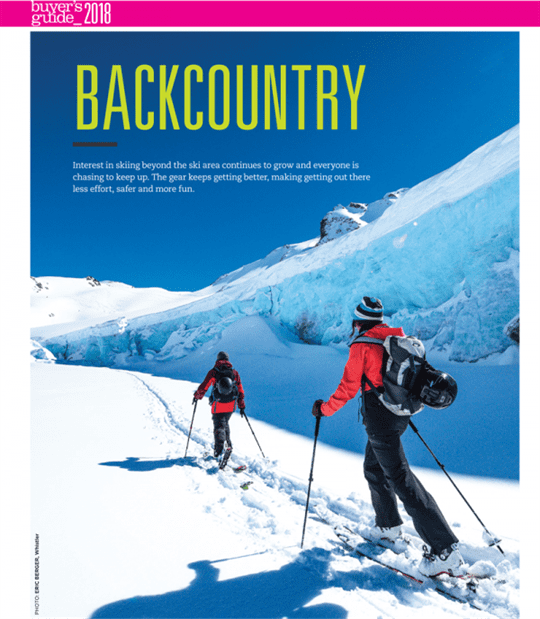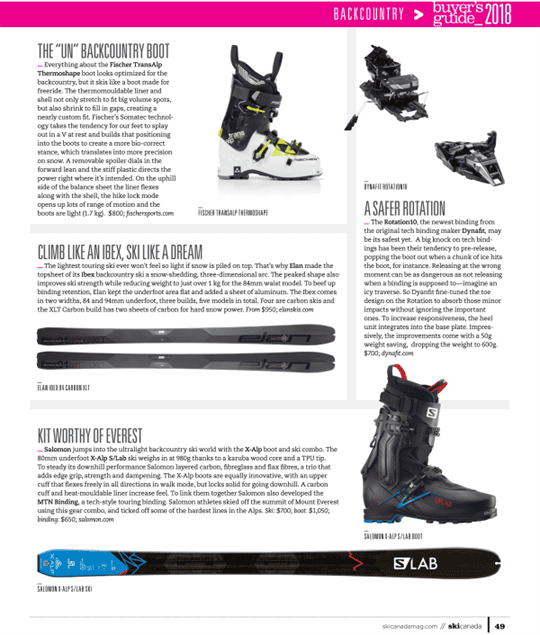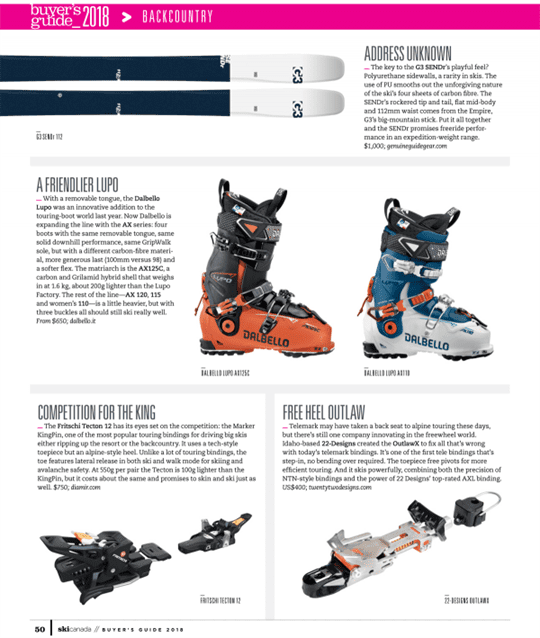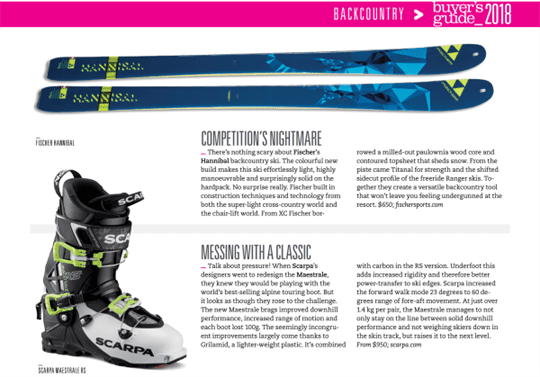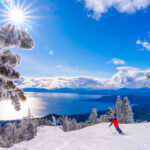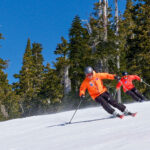Interest in skiing beyond the ski area continues to grow and everyone is chasing to keep up. The gear keeps getting better, making getting out there less effort, safer and more fun.
photo: ERIC BERGER * snow: Whistlerby Ryan Stuart, technical editor, in Buyer’s Guide 2018 issue
THE “UN” BACKCOUNTRY BOOT
Everything about the Fischer TransAlp Thermoshape boot looks optimized for the backcountry, but it skis like a boot made for freeride. The thermomouldable liner and shell not only stretch to fit big volume spots, but also shrink to fill in gaps, creating a nearly custom fit. Fischer’s Somatec technology takes the tendency for our feet to splay out in a V at rest and builds that positioning into the boots to create a more bio-correct stance, which translates into more precision on snow. A removable spoiler dials in the forward lean and the stiff plastic directs the power right where it’s intended. On the uphill side of the balance sheet the liner flexes along with the shell, the hike lock mode opens up lots of range of motion and the boots are light (1.7 kg). $800; fischersports.com
A SAFER ROTATION
The Rotation10, the newest binding from the original tech binding maker Dynafit, may be its safest yet. A big knock on tech bindings has been their tendency to pre-release, popping the boot out when a chunk of ice hits the boot, for instance. Releasing at the wrong moment can be as dangerous as not releasing when a binding is supposed to—imagine an icy traverse. So Dyanfit fine-tuned the toe design on the Rotation to absorb those minor impacts without ignoring the important ones. To increase responsiveness, the heel unit integrates into the base plate. Impressively, the improvements come with a 50g weight saving, dropping the weight to 600g. $700; dynafit.com
CLIMB LIKE AN IBEX, SKI LIKE A DREAM
The lightest touring ski ever won’t feel so light if snow is piled on top. That’s why Elan made the topsheet of its Ibex backcountry ski a snow-shedding, three-dimensional arc. The peaked shape also improves ski strength while reducing weight to just over 1 kg for the 84mm waist model. To beef up binding retention, Elan kept the underfoot area flat and added a sheet of aluminum. The Ibex comes in two widths, 84 and 94mm underfoot, three builds, five models in total. Four are carbon skis and the XLT Carbon build has two sheets of carbon for hard snow power. From $950; elanskis.com
KIT WORTHY OF EVEREST
Salomon jumps into the ultralight backcountry ski world with the X-Alp boot and ski combo. The 80mm underfoot X-Alp S/Lab ski weighs in at 980g thanks to a karuba wood core and a TPU tip. To steady its downhill performance Salomon layered carbon, fibreglass and flax fibres, a trio that adds edge grip, strength and dampening. The X-Alp boots are equally innovative, with an upper cuff that flexes freely in all directions in walk mode, but locks solid for going downhill. A carbon cuff and heat-mouldable liner increase feel. To link them together Salomon also developed the MTN Binding, a tech-style touring binding. Salomon athletes skied off the summit of Mount Everest using this gear combo, and ticked off some of the hardest lines in the Alps. Ski: $700; boot: $1,050; binding: $650; salomon.com
ADDRESS UNKNOWN
The key to the G3 SENDr’s playful feel? Polyurethane sidewalls, a rarity in skis. The use of PU smooths out the unforgiving nature of the ski’s four sheets of carbon fibre. The SENDr’s rockered tip and tail, flat mid-body and 112mm waist comes from the Empire, G3’s big-mountain stick. Put it all together and the SENDr promises freeride performance in an expedition-weight range. $1,000; genuineguidegear.com
A FRIENDLIER LUPO
With a removable tongue, the Dalbello Lupo was an innovative addition to the touring-boot world last year. Now Dalbello is expanding the line with the AX series: four boots with the same removable tongue, same solid downhill performance, same GripWalk sole, but with a different carbon-fibre material, more generous last (100mm versus 98) and a softer flex. The matriarch is the AX125C, a carbon and Grilamid hybrid shell that weighs in at 1.6 kg, about 200g lighter than the Lupo Factory. The rest of the line—AX 120, 115 and women’s 110—is a little heavier, but with three buckles all should still ski really well. From $650; dalbello.it
COMPETITION FOR THE KING
The Fritschi Tecton 12 has its eyes set on the competition: the Marker KingPin, one of the most popular touring bindings for driving big skis either ripping up the resort or the backcountry. It uses a tech-style toepiece but an alpine-style heel. Unlike a lot of touring bindings, the toe features lateral release in both ski and walk mode for skiing and avalanche safety. At 550g per pair the Tecton is 100g lighter than the KingPin, but it costs about the same and promises to skin and ski just as well. $750; diamir.com
FREE HEEL OUTLAW
Telemark may have taken a back seat to alpine touring these days, but there’s still one company innovating in the freewheel world. Idaho-based 22-Designs created the OutlawX to fix all that’s wrong with today’s telemark bindings. It’s one of the first tele bindings that’s step-in, no bending over required. The toepiece free pivots for more efficient touring. And it skis powerfully, combining both the precision of NTN-style bindings and the power of 22 Designs’ top-rated AXL binding. US$400; twentytwodesigns.com
COMPETITION’S NIGHTMARE
There’s nothing scary about Fischer’s Hannibal backcountry ski. The colourful new build makes this ski effortlessly light, highly manoeuvrable and surprisingly solid on the hardpack. No surprise really. Fischer built in construction techniques and technology from both the super-light cross-country world and the chair-lift world. From XC Fischer borrowed a milled-out paulownia wood core and contoured topsheet that sheds snow. From the piste came Titanal for strength and the shifted sidecut profile of the freeride Ranger skis. Together they create a versatile backcountry tool that won’t leave you feeling undergunned at the resort. $650; fischersports.com
MESSING WITH A CLASSIC
Talk about pressure! When Scarpa’s designers went to redesign the Maestrale, they knew they would be playing with the world’s best-selling alpine touring boot. But it looks as though they rose to the challenge. The new Maestrale brags improved downhill performance, increased range of motion and each boot lost 100g. The seemingly incongruent improvements largely come thanks to Grilamid, a lighter-weight plastic. It’s combined with carbon in the RS version. Underfoot this adds increased rigidity and therefore better power-transfer to ski edges. Scarpa increased the forward walk mode 23 degrees to 60 degrees range of fore-aft movement. At just over 1.4 kg per pair, the Maestrale manages to not only stay on the line between solid downhill performance and not weighing skiers down in the skin track, but raises it to the next level. From $950; scarpa.com
